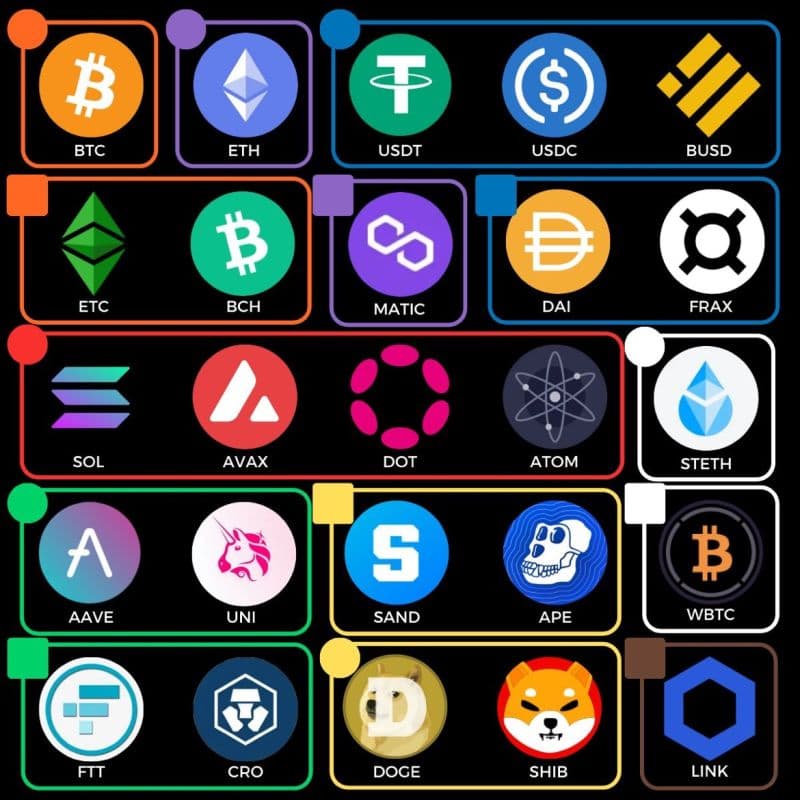In Telecom, the value of blockchain lies in the Security, Transparency, Data Immutability and Control it provides across the ecosystem at every point of a transaction.
While it’s not ( yet ) widely used in Telecom, blockchain is the base of cryptos, so i thought it would be nice to share a good summary about it too (Cryptos & Tokens).
5G will “need” blockchain.
![]() ULTIMATE CRYPTO TOKEN GUIDE
ULTIMATE CRYPTO TOKEN GUIDE
Shapes (![]() ) = KEY
) = KEY
![]() Bitcoin (BTC)
Bitcoin (BTC)
Bitcoin is hard money, a store of value, a reserve asset, Gold 2.0, and ultra-secure global settlement network.
![]() Forked Coins
Forked Coins
Bitcoin Cash (BCH), Ethereum Classic (ETH)
"Copycat” coins. They’re the USFL to the NFL–the product of disagreements on rules of the system, so the code is “forked” and a new token is created.
![]() Ethereum (ETH)
Ethereum (ETH)
Ethereum is programmable money. It is the dominant currency of web3 and powers most of decentralized finance (DeFi) and NFT marketplaces.
![]() Ethereum Scaling Solutions
Ethereum Scaling Solutions
Polygon (MATIC)
AKA “Layer 2’s.” Rather than compete with Ethereum, these projects build on top of Ethereum to help increase transaction throughput and lower fees. See also: Arbitrum, Optimism, zkSync
![]() Centralized Stablecoins
Centralized Stablecoins
Tether (USDT), USD Coin (USDC), Binance USD (BUSD)
Digital currencies pegged to the dollar. Centralized stablecoins are issued by non-blockchain entities, and are (allegedly) backed 1:1 by fiat collateral.
![]() Decentralized Stablecoins
Decentralized Stablecoins
DAI, FRAX (R.I.P. UST)
Decentralized stablecoins live entirely on the blockchain. DAI is issued and maintained by Maker DAO and uses over-collateralization to maintain its peg. FRAX uses both collateralization and an algorithm to maintain its peg.
![]() Ethereum Competitors
Ethereum Competitors
Solana (SOL), Avalanche (AVAX), Polkadot (DOT), Cosmos (ATOM)
AKA “ETH Killers” and “Alternative Layer 1’s.” These projects have similar use cases to Ethereum, but seek to be better somehow (speed, TX costs, etc.).
![]() Staked Tokens
Staked Tokens
LIDO Staked ETH (stETH)
Staking is like putting cash in a high-yield savings account. You lock up coins to help secure the network and earn interest in return. If you stake ETH on Lido, you are given Lido Staked ETH (stETH) that accrues interest.
![]() Wrapped Tokens
Wrapped Tokens
Wrapped Bitcoin (WBTC)
Similar to running Windows on a Mac. Bitcoin isn’t compatible with the Ethereum network, but you can “wrap” Bitcoin (or buy wrapped Bitcoin) to use in DeFi.
![]() DeFi Tokens
DeFi Tokens
AAVE (AAVE), Uniswap (UNI)
Decentralized Finance (DeFi) allows users to become their own bank and borrow, lend, save, invest, etc. without a middleman. DeFi tokens typically grant voting power or can be staked to earn interest.
![]() Centralized Exchanges
Centralized Exchanges
FTX (FTT), [Crypto DOT com] (CRO)
Native tokens of crypto exchange companies. Essentially tokenized loyalty points.
![]() Metaverse/ Ecosystem Tokens
Metaverse/ Ecosystem Tokens
Sandbox (SAND), ApeCoin (APE)
Currencies associated with virtual worlds that buy virtual land, in-game assets, NFTs, etc. Ex: APE = BAYC’s native token.
![]() Memecoins
Memecoins
Dogecoin (DOGE), Shiba Inu (SHIB)
Hot take: everyone knows that coins like these are a scam, but they’re just trying to time their entry/exit to make money.
![]() Specific-Application Tokens
Specific-Application Tokens
Chainlink (LINK)
Coins like Chainlink have specific applications (e.g., Chainlink bridges data from web2 to web3 to create hybrid smart contracts).
Source: Trevor Ward, CPA on LinkedIn: #cryptocurrency #defi #blockchain #web3 | 297 comments
